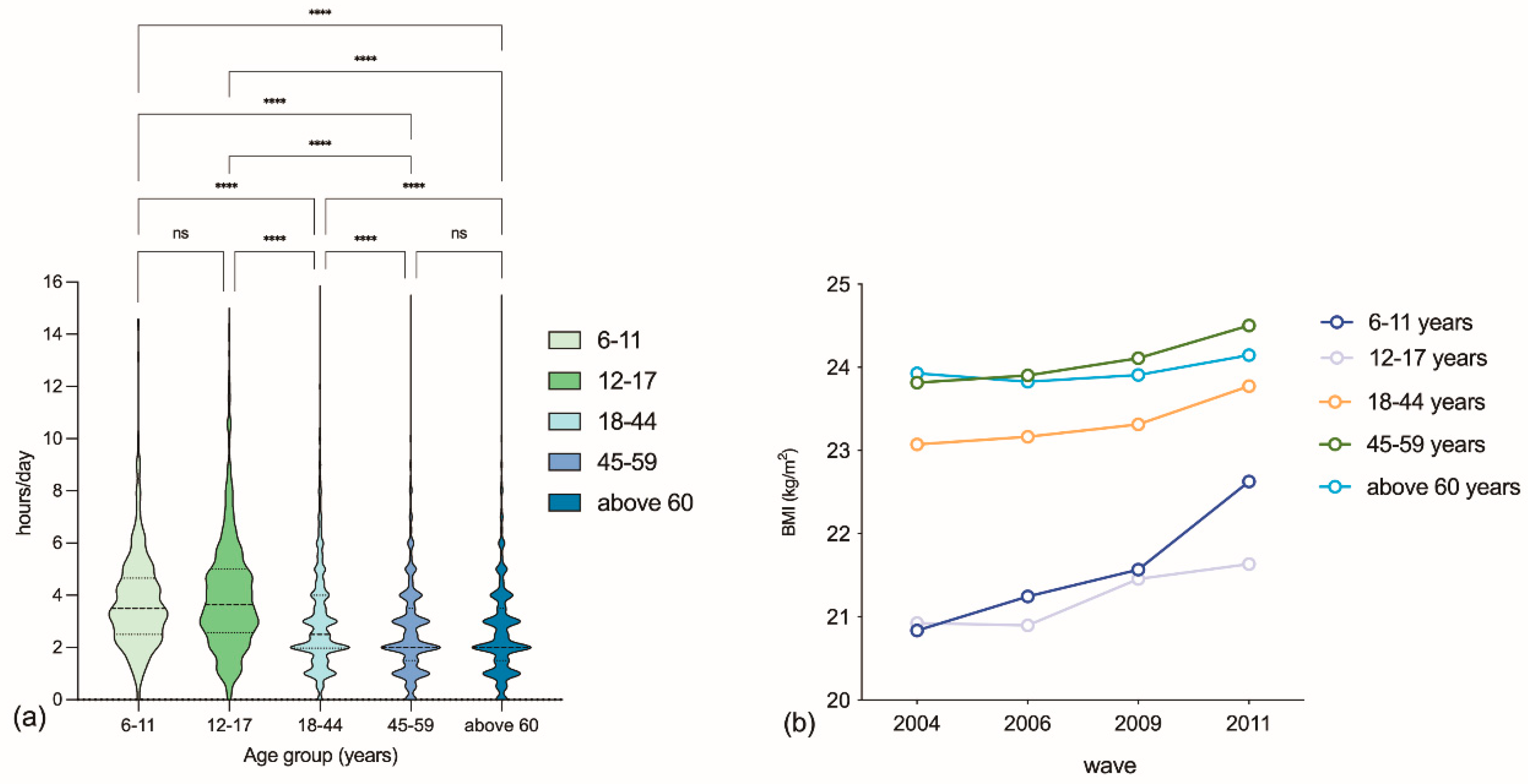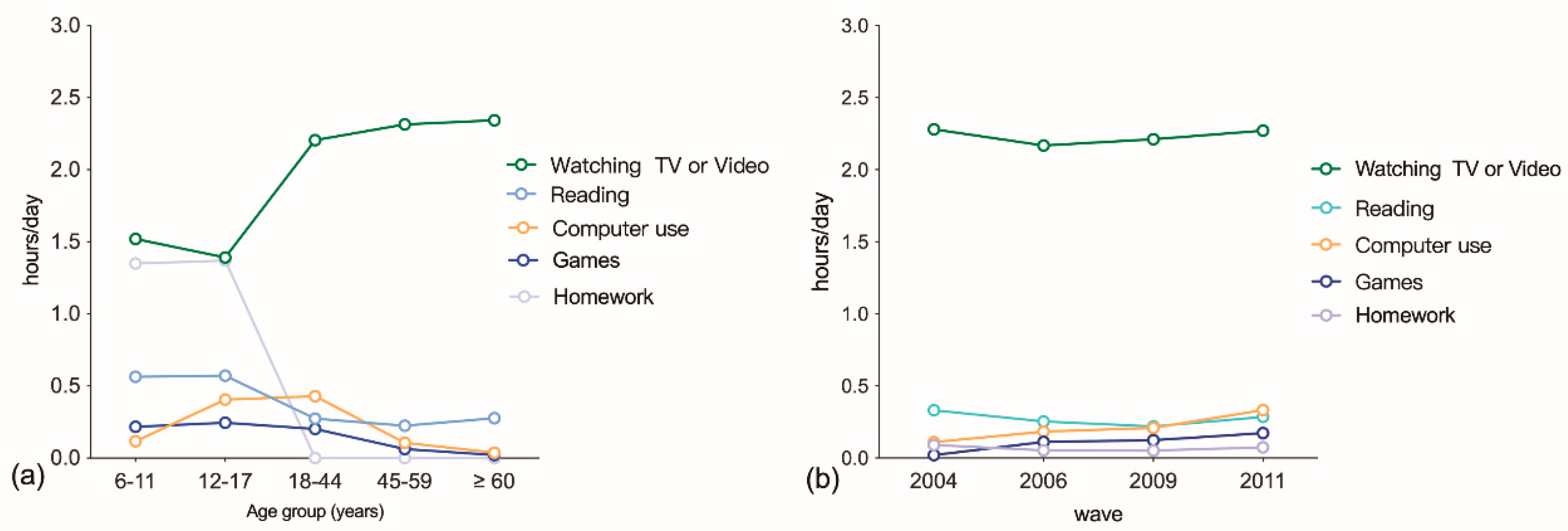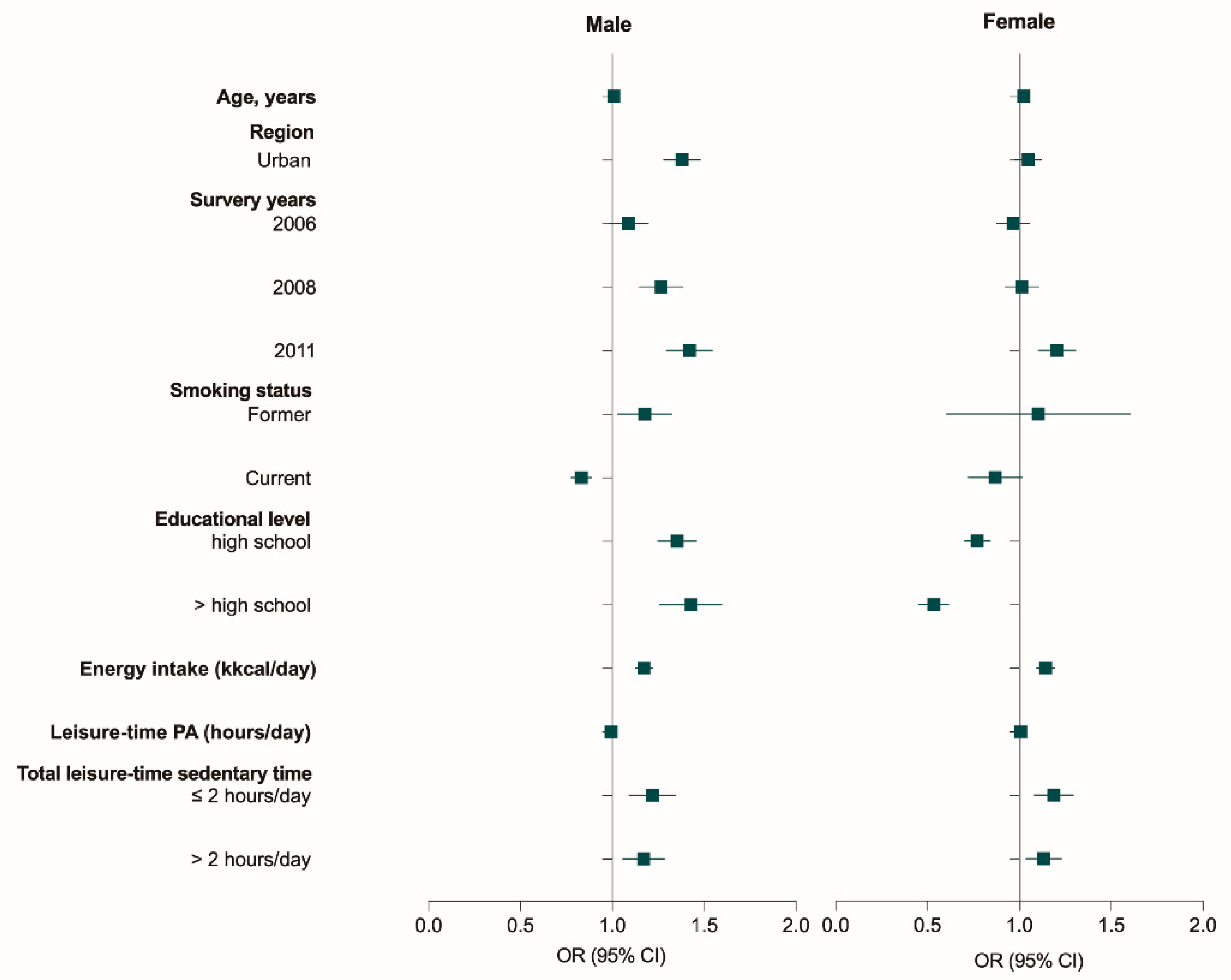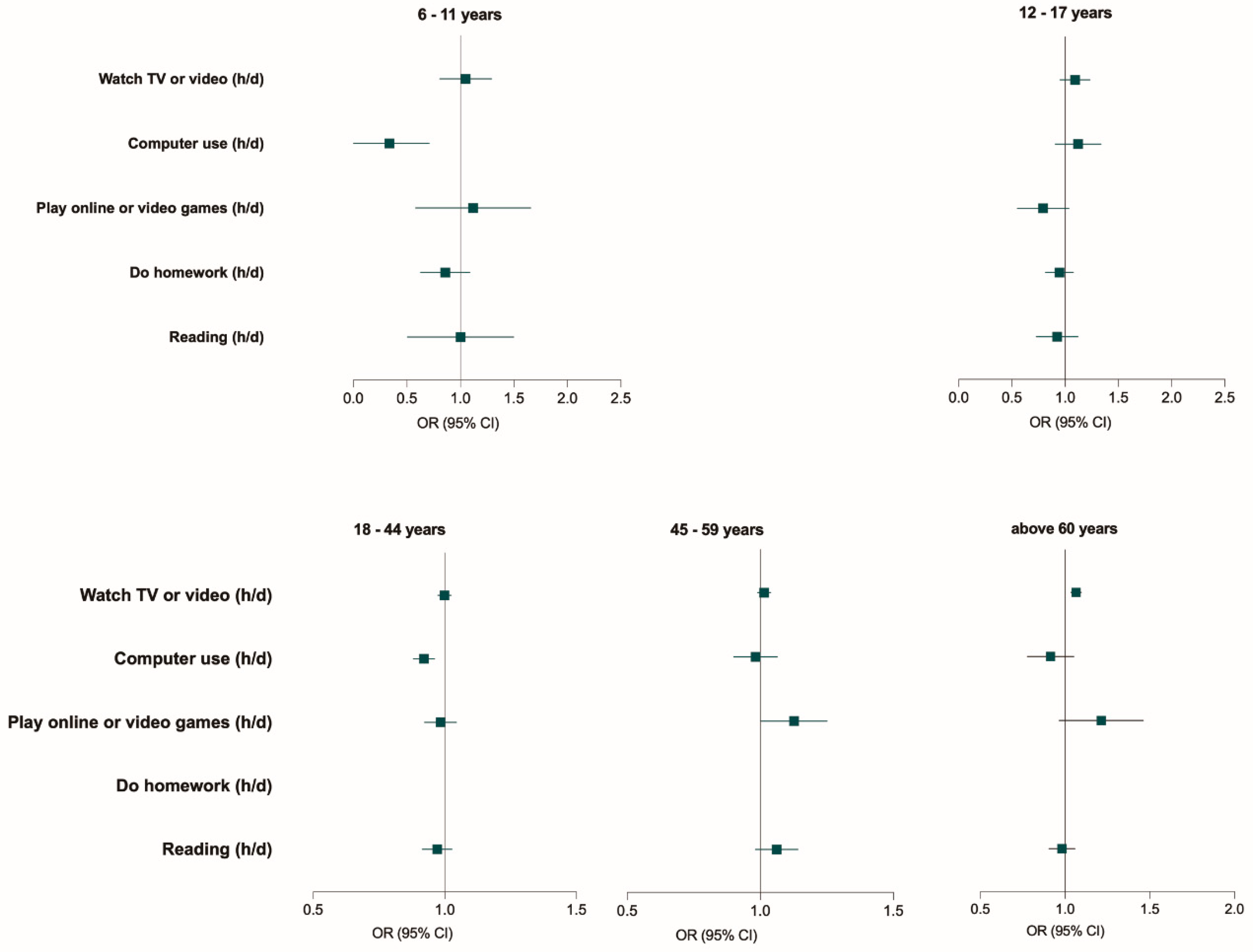Association between Sedentary Behavior during Leisure Time and Excessive Weight in Chinese Children, Adolescents, and Adults
Abstract
1. Introduction
2. Materials and Methods
2.1. Study Population
2.2. Anthropometrics and Weight Status
2.3. Assessment of Leisure-Time Sedentary Behavior
2.4. Assessment of Leisure-Time Physical Activities
2.5. Assessment of Energy Intakes
2.6. Covariates
2.7. Statistical Analyses
3. Results
3.1. Socio-Demographic Characteristics
3.2. Overweight and Obesity Status
3.3. Energy Intake and Physical Activity Status
3.4. Leisure-Time Sedentary Behavior Status
3.5. Leisure-Time Sedentary Behaviors Associated with Excessive Weight
4. Discussion
Strength and Limitation
5. Conclusions
Supplementary Materials
Author Contributions
Funding
Institutional Review Board Statement
Informed Consent Statement
Data Availability Statement
Acknowledgments
Conflicts of Interest
References
- Li, F.; Mao, L.; Chen, P. Physical activity and prevention of chronic disease in Chinese youth: A public health approach. J. Sport Health Sci. 2019, 8, 512–515. [Google Scholar] [CrossRef] [PubMed]
- Tian, Y.; Jiang, C.; Wang, M.; Cai, R.; Zhang, Y.; He, Z.; Wang, H.; Wu, D.; Wang, F.; Liu, X.; et al. BMI, leisure-time physical activity, and physical fitness in adults in China: Results from a series of national surveys, 2000–2014. Lancet Diabetes Endocrinol. 2016, 4, 487–497. [Google Scholar] [CrossRef] [PubMed]
- Mandviwala, T.; Khalid, U.; Deswal, A. Obesity and Cardiovascular Disease: A Risk Factor or a Risk Marker? Curr. Atheroscler. Rep. 2016, 18, 21. [Google Scholar] [CrossRef] [PubMed]
- Calle, E.E.; Kaaks, R. Overweight, obesity and cancer: Epidemiological evidence and proposed mechanisms. Nat. Rev. Cancer 2004, 4, 579–591. [Google Scholar] [CrossRef]
- Bjerregaard, L.G.; Baker, J.L. Change in Overweight from Childhood to Early Adulthood and Risk of Type 2 Diabetes. N. Engl. J. Med. 2018, 378, 2537–2538. [Google Scholar] [CrossRef]
- Monda, V.; La Marra, M.; Perrella, R.; Caviglia, G.; Iavarone, A.; Chieffi, S.; Messina, G.; Carotenuto, M.; Monda, M.; Messina, A. Obesity and brain illness: From cognitive and psychological evidences to obesity paradox. Diabetes Metab. Syndr. Obes. 2017, 10, 473–479. [Google Scholar] [CrossRef]
- Van Dammen, L.; Wekker, V.; de Rooij, S.R.; Groen, H.; Hoek, A.; Roseboom, T.J. A systematic review and meta-analysis of lifestyle interventions in women of reproductive age with overweight or obesity: The effects on symptoms of depression and anxiety. Obes. Rev. 2018, 19, 1679–1687. [Google Scholar] [CrossRef]
- Lavie, C.J.; Ozemek, C.; Carbone, S.; Katzmarzyk, P.T.; Blair, S.N. Sedentary Behavior, Exercise, and Cardiovascular Health. Circ. Res. 2019, 124, 799–815. [Google Scholar] [CrossRef]
- Ng, S.W.; Popkin, B.M. Time use and physical activity: A shift away from movement across the globe. Obes. Rev. 2012, 13, 659–680. [Google Scholar] [CrossRef]
- Bull, F.C.; Al-Ansari, S.S.; Biddle, S.; Borodulin, K.; Buman, M.P.; Cardon, G.; Carty, C.; Chaput, J.-P.; Chastin, S.; Chou, R.; et al. World Health Organization 2020 guidelines on physical activity and sedentary behaviour. Br. J. Sport. Med. 2020, 54, 1451–1462. [Google Scholar] [CrossRef]
- Felez-Nobrega, M.; Raine, L.B.; Haro, J.M.; Wijndaele, K.; Koyanagi, A. Temporal trends in leisure-time sedentary behavior among adolescents aged 12–15 years from 26 countries in Asia, Africa, and the Americas. Int. J. Behav. Nutr. Phys. Act. 2020, 17, 102. [Google Scholar] [CrossRef] [PubMed]
- Yang, L.; Cao, C.; Kantor, E.D.; Nguyen, L.H.; Zheng, X.; Park, Y.; Giovannucci, E.L.; Matthews, C.E.; Colditz, G.A.; Cao, Y.; et al. Trends in Sedentary Behavior Among the US Population, 2001–2016. JAMA 2019, 321, 1587–1597. [Google Scholar] [CrossRef]
- Stamatakis, E.; Gale, J.; Bauman, A.; Ekelund, U.; Hamer, M.; Ding, D. Sitting Time, Physical Activity, and Risk of Mortality in Adults. J. Am. Coll. Cardiol. 2019, 73, 2062–2072. [Google Scholar] [CrossRef] [PubMed]
- Loyen, A.; Clarke-Cornwell, A.M.; Anderssen, S.A.; Hagströmer, M.; Sardinha, L.B.; Sundquist, K.; Ekelund, U.; Steene-Johannessen, J.; Baptista, F.; Hansen, H.B.; et al. Sedentary Time and Physical Activity Surveillance Through Accelerometer Pooling in Four European Countries. Sport. Med. 2017, 47, 1421–1435. [Google Scholar] [CrossRef] [PubMed]
- Fu, W.; Zhao, S.; Zhang, Y.; Chai, P.; Goss, J. Research in health policy making in China: Out-of-pocket payments in Healthy China 2030. BMJ 2018, 360, k234. [Google Scholar] [CrossRef] [PubMed]
- Zhang, B.; Zhai, F.Y.; Du, S.F.; Popkin, B.M. The China Health and Nutrition Survey, 1989–2011. Obes. Rev. 2014, 15 (Suppl. S1), 2–7. [Google Scholar] [CrossRef]
- Popkin, B.M.; Du, S.; Zhai, F.; Zhang, B. Cohort Profile: The China Health and Nutrition Survey--monitoring and understanding socio-economic and health change in China, 1989–2011. Int. J. Epidemiol. 2010, 39, 1435–1440. [Google Scholar] [CrossRef]
- Liu, Z.; Xing, B.; Xue, Z.Z. Group of China Obesity Task Force. Body mass index reference norm for screening overweight and obesity in Chinese children and adolescents. Zhonghua Liuxingbingxue Zazhi 2004, 25, 97–102. (In Chinese) [Google Scholar]
- Blüher, M. Obesity: Global epidemiology and pathogenesis. Nat. Rev. Endocrinol. 2019, 15, 288–298. [Google Scholar] [CrossRef]
- Pan, X.F.; Wang, L.; Pan, A. Epidemiology and determinants of obesity in China. Lancet Diabetes Endocrinol. 2021, 9, 373–392. [Google Scholar] [CrossRef]
- Silva, D.A.S.; Chaput, J.P.; Katzmarzyk, P.T.; Fogelholm, M.; Hu, G.; Maher, C.; Tremblay, M.S. Physical Education Classes, Physical Activity, and Sedentary Behavior in Children. Med. Sci. Sport. Exerc. 2018, 50, 995–1004. [Google Scholar] [CrossRef]
- Vancampfort, D.; Stubbs, B.; Mugisha, J.; Firth, J.; Van Damme, T.; Smith, L.; Koyanagi, A. Leisure-time sedentary behavior and suicide attempt among 126,392 adolescents in 43 countries. J. Affect. Disord. 2019, 250, 346–353. [Google Scholar] [CrossRef]
- Rawlings, G.H.; Williams, R.K.; Clarke, D.J.; English, C.; Fitzsimons, C.; Holloway, I.; Lawton, R.; Mead, G.; Patel, A.; Forster, A. Exploring adults’ experiences of sedentary behaviour and participation in non-workplace interventions designed to reduce sedentary behaviour: A thematic synthesis of qualitative studies. BMC Public Health 2019, 19, 1099. [Google Scholar] [CrossRef]
- Li, M.; Xue, H.; Wang, W.; Wang, Y. Parental Expectations and Child Screen and Academic Sedentary Behaviors in China. Am. J. Prev. Med. 2017, 52, 680–689. [Google Scholar] [CrossRef]
- Blackburn, N.E.; Wilson, J.J.; McMullan, I.I.; Caserotti, P.; Giné-Garriga, M.; Wirth, K.; Tully, M.A. The effectiveness and complexity of interventions targeting sedentary behaviour across the lifespan: A systematic review and meta-analysis. Int. J. Behav. Nutr. Phys. Act. 2020, 17, 53. [Google Scholar] [CrossRef]
- Auhuber, L.; Vogel, M.; Grafe, N.; Kiess, W.; Poulain, T. Leisure Activities of Healthy Children and Adolescents. Int. J. Environ. Res. Public Health 2019, 16, 2078. [Google Scholar] [CrossRef]
- Tremblay, M.S.; Colley, R.C.; Saunders, T.J.; Healy, G.N.; Owen, N. Physiological and health implications of a sedentary lifestyle. Appl. Physiol. Nutr. Metab. 2010, 35, 725–740. [Google Scholar] [CrossRef]
- Xiao, Y.; Becerik-Gerber, B.; Lucas, G.; Roll, S.C. Impacts of Working From Home During COVID-19 Pandemic on Physical and Mental Well-Being of Office Workstation Users. J. Occup. Environ. Med. 2021, 63, 181–190. [Google Scholar] [CrossRef]
- Kim, Y.; Yeung, S.L.A.; Sharp, S.J.; Wang, M.; Jang, H.; Luo, S.; Brage, S.; Wijndaele, K. Genetic susceptibility, screen-based sedentary activities and incidence of coronary heart disease. BMC Med. 2022, 20, 188. [Google Scholar] [CrossRef]
- Hallgren, M.; Nguyen, T.T.; Owen, N.; Stubbs, B.; Vancampfort, D.; Lundin, A.; Dunstan, D.; Bellocco, R.; Lagerros, Y.T. Cross-sectional and prospective relationships of passive and mentally active sedentary behaviours and physical activity with depression. Br. J. Psychiatry 2020, 217, 413–419. [Google Scholar] [CrossRef]
- Hallgren, M.; Dunstan, D.W.; Owen, N. Passive versus mentally active sedentary behaviors and depression. Exerc. Sport Sci. Rev. 2020, 48, 20–27. [Google Scholar] [CrossRef] [PubMed]
- Raichlen, D.A.; Klimentidis, Y.C.; Sayre, M.K.; Bharadwaj, P.K.; Lai, M.H.C.; Wilcox, R.R.; Alexander, G.E. Leisure-time sedentary behaviors are differentially associated with all-cause dementia regardless of engagement in physical activity. Proc. Natl. Acad. Sci. USA 2022, 119, e2206931119. [Google Scholar] [CrossRef] [PubMed]
- Da Silva Coqueiro, R.; de Queiroz, B.M.; Oliveira, D.S.; das Merces, M.C.; Oliveira Carneiro, J.A.; Pereira, R.; Fernandes, M.H. Cross-sectional relationships between sedentary behavior and frailty in older adults. J. Sport. Med. Phys. Fit. 2017, 57, 825–830. [Google Scholar] [CrossRef] [PubMed]
- Hsueh, M.C.; Rutherford, R.; Huang, Y.H.; Chang Chien, H.Y.; Chang, C.H.; Park, J.H.; Liao, Y. Are Older Adults without a Healthy Diet Less Physically Active and More Sedentary? Nutrients 2019, 11, 1119. [Google Scholar] [CrossRef] [PubMed]
- Cleland, C.; Ferguson, S.; Ellis, G.; Hunter, R.F. Validity of the International Physical Activity Questionnaire (IPAQ) for assessing moderate-to-vigorous physical activity and sedentary behaviour of older adults in the United Kingdom. BMC Med. Res. Methodol. 2018, 18, 176. [Google Scholar] [CrossRef]
- Copeland, J.L.; Ashe, M.C.; Biddle, S.J.K.; Brown, W.J.; Buman, M.P.; Chastin, S.; Gardiner, P.A.; Inoue, S.; Jefferis, B.J.; Oka, K.; et al. Sedentary time in older adults: A critical review of measurement, associations with health, and interventions. Br. J. Sport. Med. 2017, 51, 1539. [Google Scholar] [CrossRef]




| Variables | OR (95% C.I.) | ||||
|---|---|---|---|---|---|
| 6–11 y | 12–17 y | 18–44 y | 45–60 y | >=60 y | |
| Excessive Weight (Overweight and Obesity) | |||||
| Watch TV or video (h/d) | 1.030 (0.817–1.299) | 1.087 (0.955–1.237) | 0.999 (0.974–1.024) | 1.014 (0.990–1.039) | 1.065 (1.035–1.095) |
| Computer use (h/d) | 0.200 (0.053–0.755) | 1.108 (0.915–1.343) | 0.921 (0.881–0.962) | 0.980 (0.902–1.065) | 0.907 (0.781–1.054) |
| Play online or video games (h/d) | 1.033 (0.630–1.684) | 0.768 (0.563–1.047) | 0.983 (0.924–1.045) | 1.122 (1.005–1.253) | 1.196 (0.975–1.469) |
| Do homework (h/d) | 0.838 (0.640–1.099) | 0.940 (0.819–1.078) | - | - | - |
| Reading (h/d) | 1.080 (0.741–1.574) | 0.910 (0.736–1.126) | 0.970 (0.916–1.028) | 1.059 (0.982–1.142) | 0.979 (0.906–1.058) |
Disclaimer/Publisher’s Note: The statements, opinions and data contained in all publications are solely those of the individual author(s) and contributor(s) and not of MDPI and/or the editor(s). MDPI and/or the editor(s) disclaim responsibility for any injury to people or property resulting from any ideas, methods, instructions or products referred to in the content. |
© 2023 by the authors. Licensee MDPI, Basel, Switzerland. This article is an open access article distributed under the terms and conditions of the Creative Commons Attribution (CC BY) license (https://creativecommons.org/licenses/by/4.0/).
Share and Cite
Su, Y.; Li, X.; Li, H.; Xu, J.; Xiang, M. Association between Sedentary Behavior during Leisure Time and Excessive Weight in Chinese Children, Adolescents, and Adults. Nutrients 2023, 15, 424. https://doi.org/10.3390/nu15020424
Su Y, Li X, Li H, Xu J, Xiang M. Association between Sedentary Behavior during Leisure Time and Excessive Weight in Chinese Children, Adolescents, and Adults. Nutrients. 2023; 15(2):424. https://doi.org/10.3390/nu15020424
Chicago/Turabian StyleSu, Ya, Xueyuan Li, Huilun Li, Jiawei Xu, and Mi Xiang. 2023. "Association between Sedentary Behavior during Leisure Time and Excessive Weight in Chinese Children, Adolescents, and Adults" Nutrients 15, no. 2: 424. https://doi.org/10.3390/nu15020424
APA StyleSu, Y., Li, X., Li, H., Xu, J., & Xiang, M. (2023). Association between Sedentary Behavior during Leisure Time and Excessive Weight in Chinese Children, Adolescents, and Adults. Nutrients, 15(2), 424. https://doi.org/10.3390/nu15020424





